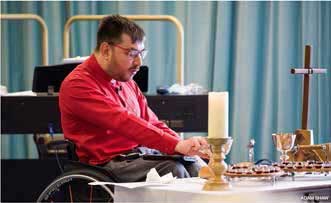Revd Katie Tupling, part-time Disability Adviser for Oxford Diocese (Church of England) and co-founder of Disability and Jesus, considers how we can ensure that no one feels excluded from our communion services.
I am a disabled Anglican priest who uses crutches (and sometimes a wheelchair) so I’m often asked about including people in Communion services, with concerns around how disabled people can be unintentionally excluded from full participation both as recipients and servers. Let’s have a brief look at some examples, and notice how we can adjust our current practices to become more inclusive.
Place and space
One of the first questions to ask is ‘where is the celebrant/altar/holy table, in relation to the congregation?’ If the person leading the liturgy is a long way from the congregation it can be hard to see what is happening, and difficult to hear the spoken liturgy if there is no microphone. Could Communion be celebrated from a more central space? Could a table/temporary altar be brought to the front of the congregation space?

Revd Haydon Spenceley sits to preside
at Communion at Emmanuel Church,
Northampton.
People and posture
Do the congregation remain standing throughout the Eucharistic Prayer/communion liturgy? If so, this may have an impact on people living with fatigue/ME for whom standing drains energy. People standing in front of those who need/choose to sit, or children who are shorter than adults, will also restrict any view of Communion. Perhaps after the opening sentences, everyone could be invited to sit down together.
Movement
How do people receive the bread and wine? In many churches the congregation leave their seats/pews and move to the front of the building (often up steps to an altar rail). There may be an expectation to kneel. For some people this may not be possible, so sometimes provision is made to bring Communion to them in their pews/seats. However, while this is well-meant, for some it can feel like second-best administration as Communion is brought-to rather than received together. Instead, could the Communion be administered from the nave/front of the worship space and be brought nearer to all of the people, not just some (this would also avoid the need to go up steps)?
Disabled priests/leaders
When I go to a church as a visiting priest to take a Communion service, I bring with me a tall ‘bar stool’ and a shorter ‘kitchen stool’ – one goes behind the altar so that I can sit while presiding and still be seen above the table, the other is placed at a distribution/serving position so that I can sit to administer the bread/wafers/wine. Someone is tasked with carrying the things I will need bringing from the altar. This models both disabled ministry and good teamwork!
What do you notice in your place of worship?
Can you talk with disabled people about their experiences? What adjustments could you make together?
Further resources from Katie
Want to learn more?
Not a Roots subscriber?
